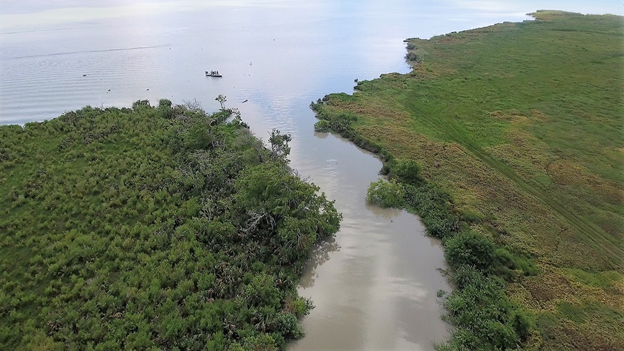Did you know that the San Antonio River flows just over 240 miles through Bexar, Wilson, Karnes, Goliad, and Refugio counties where it converges with the Guadalupe River before finally flowing into San Antonio Bay on the Gulf of Mexico? As part of our commitment to safe, clean, enjoyable creeks and rivers, the San Antonio River Authority’s (River Authority) works actively to improve the water quality within the San Antonio River Basin because the river’s health has a direct effect on the well-being of the bays and estuaries along the Texas coast.
Learn more about the bays and estuaries and how you can help protect these systems by joining us in our efforts to keep area creeks and rivers clean for future generations!
Introduction to Bays & Estuaries
Bays and estuaries are part of a complex and dynamic system that support a diverse community of plants and wildlife that depend on its health for survival. An estuary is a partially enclosed body of water where streams or rivers enter and mix freshwater with saltwater. Within bays and estuaries, you will also find marshes, which are low-lying land that floods during wet seasons and high tides. The marsh is critical because it is made of sediment containing nutrients important for vegetation and wildlife. The vegetation allows natural erosion and deposition to take place. Healthy bays and estuaries can also provide significant buffering of the effects of storms on the Texas coast by absorbing the storm surge like a sponge.
Importance of Protecting our Bays & Estuaries
It is important to conserve the bays and estuaries to help ensure the safety of communities during future storm events. Destroying an estuary can lead to flood-prone conditions, especially during hurricane season, where many storm events originate and may pose a threat to the San Antonio Bay area and beyond.
The San Antonio Bay also supports one of the rarest bird species in North America. A significant population of Whooping Cranes migrates from Canada to the bays and estuaries near San Antonio Bay every year. The primary food supply in the estuary for Whooping Cranes are Blue Crabs and the small, red wolf berries. A healthy bay and estuary ecosystem helps sustain this important food source which help keep the Whooping Crane population in healthy numbers. The River Authority engages with numerous partners at the state, local, and federal level to foster understanding that healthy waters upstream contribute to healthy waters downstream, where the Whooping Cranes and many other species rely on a clean habitat for survival.
What You Can Do
You can continue learning about the role that bays and estuaries play in our environment and how your actions can contribute to the health of these important natural areas. The River Authority’s website has many tools and resources for audiences of all ages. The public can also request a presentation from River Authority staff to share our expertise and provide more insight on the subject.
Have you paid a visit to the San Antonio Bay? There are many recreational opportunities in the area which allow you to gain a deeper appreciation of these natural areas. Paddling, fishing, birding, wildlife tours, and beach going are just a few of the ways people can enjoy bays and estuaries. Check out the video above from our San Antonio to Seadrift documentary featuring the Texas Parks and Wildlife Seadrift Paddling Trail!





